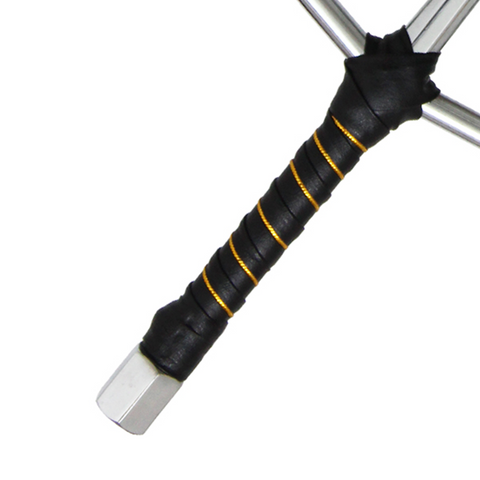The sai is a traditional close contact (melee) martial arts weapon used for both striking and blocking. Originating in Okinawa, Japan, the sai, a type of dagger with three prongs, is most notably used in Ninjutsu, Kobudo, and southern Chinese martial arts. There are numerous types of sai, and the unfamiliar language may leave you stuck in your tracks, unsure of what is what.
This guide breaks down some of the standard terms used in sai structure. Discover the meaning of monouchi, yoku, tsume, moto, tuska, tsukaagashria, and saki and why these are crucial when choosing the right sai for your martial arts training.
|
What is Sai Monouchi? The monouchi is the central, middle prong or the shaft of the sai and can be either round or faceted. |

|
 |
What is Sai Yoku? The yoku are the prong-like side guards of the sai's middle prong (monouchi) and are usually symmetrical. |
|
What is Sai Tsume? The tsume is the tip of the sai's side guard (yoku). |
|
|
|
What is Sai moto? The moto is where the guards, prongs (yoku), and the shaft (monouchi) meet at the centre of the sai. |
|
What is the Sai Tsuka? The tsuka is the handle of the sai, which can be wrapped with various materials such as cord, leather or ray skin. |
|
|
|
What is Sai Tsukaagashria? The tsukaagashria is the bottom of the handle of the Sai (tuska). |
|
What is Saki? The saki is the tip or point of the sai, which can be either sharp or blunt. |
|
What Kind of Sai is Right for Me?
| A lightweight sai, like an Aluminum Training Sai, is perfect for younger practitioners, beginners who are using the sai for training or for demonstration purposes. Due to the light weight of Aluminium, the sai will be more comfortable to hold and wield for prolonged training sessions. |  |
|
While still lightweight, the Chrome Sai are slightly heavier than the Aluminium and are great for more experienced martial artists who prefer a more weighted feel. |
 |
|
For a safe training environment for juniors, the Junior PP Sai made of polypropylene are the perfect pair. The smaller dimensions are easier to hold and lighter weight for children, and the rounded safety ends mean your students can train in a safer and controlled environment. |
 |
What Size Sai Should I Buy?
Sai are available in a range of sizes to fit different arm lengths. Measure from the tip of your extended index finger to the point of your elbow to ensure that your sai fits you appropriately. To ensure complete elbow and tricep protection when blocking, add an additional 12 to 1 inch.




